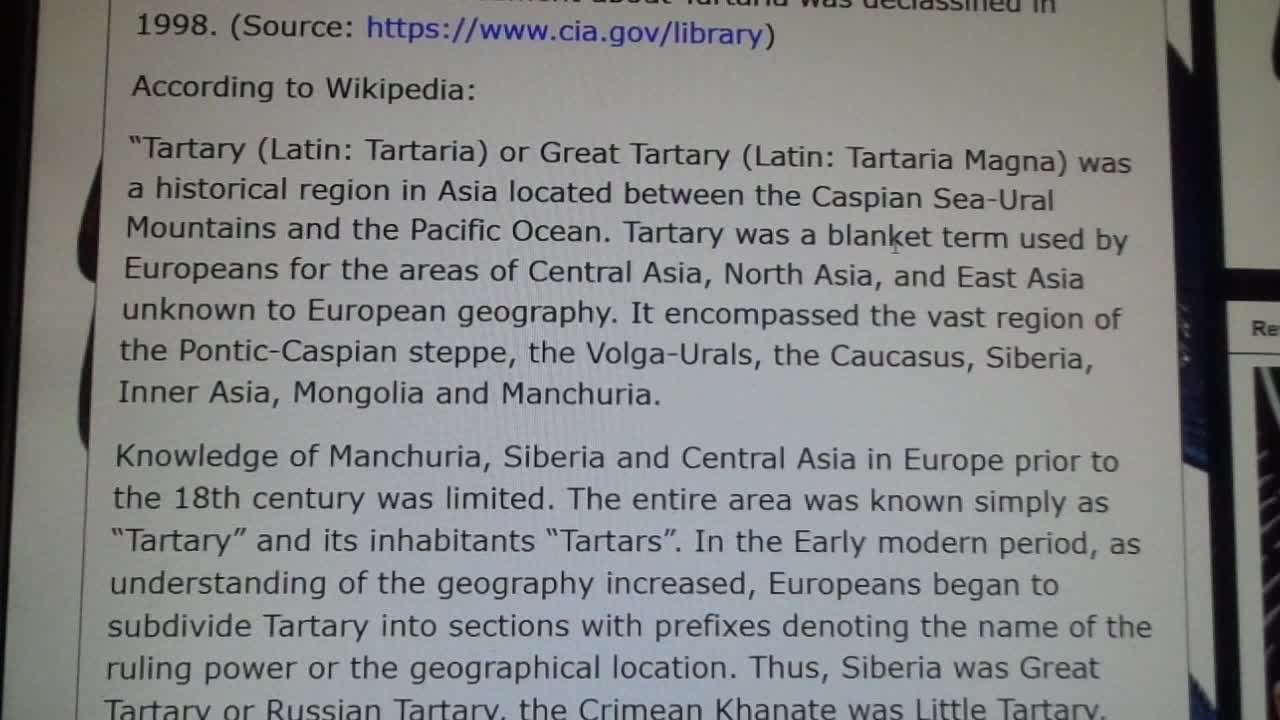Premium Only Content

Tartaria — The Mystery of an Empire Lost in History
Please Consider Donate to our 501 NonProfit, our Gmail for PayPal Donations is UchurchOfLight@gMail.com
Tartary / Tartaria — The Mystery of an Empire Lost in History Conspiracy theorists have been researching about this online and have come up with some wild ideas. This is a look into the actual facts and the info that is available about this medieval country.
"The Chinese have a proverb:
“The longest journey starts with but a single step”.
There’s a story circulating on the internet regarding a country lost in the chronicles of history.
A country that once seemed to be world known is now forgotten, buried in the sands of time. Tartaria, Tartary, or Grand Tartaria has been troubling online researchers as they dig in old maps dating back as far as to the 15th century.
The mystery that sparked the search
What intrigued the internet was a declassified document by the CIA, which mentions the deletion of this country’s history which seems to have been located in the land of modern Russia/Siberia & Asia.
According to the old world maps, at times it reached the borders of China and Mongolia. Little is known about the people inhabiting the land at that time and due to the lack of information people are still speculating if it was an area or an actual country. Europeans during the 19th century and earlier seem to have called Asian areas Tartary before they explored them and recorded them in greater detail.
Was Tartaria’s history deleted?
This is an excerpt of the declassified CIA document created in 1957.
The declassified CIA document about Tartaria was declassified in 1998. (Source: https://www.cia.gov/library)
According to Wikipedia:
“Tartary (Latin: Tartaria) or Great Tartary (Latin: Tartaria Magna) was a historical region in Asia located between the Caspian Sea-Ural Mountains and the Pacific Ocean. Tartary was a blanket term used by Europeans for the areas of Central Asia, North Asia, and East Asia unknown to European geography. It encompassed the vast region of the Pontic-Caspian steppe, the Volga-Urals, the Caucasus, Siberia, Inner Asia, Mongolia and Manchuria.
Knowledge of Manchuria, Siberia and Central Asia in Europe prior to the 18th century was limited. The entire area was known simply as “Tartary” and its inhabitants “Tartars”. In the Early modern period, as understanding of the geography increased, Europeans began to subdivide Tartary into sections with prefixes denoting the name of the ruling power or the geographical location. Thus, Siberia was Great Tartary or Russian Tartary, the Crimean Khanate was Little Tartary, Manchuria was Chinese Tartary, and western Central Asia (prior to becoming Russian Central Asia) was known as Independent Tartary.”
Wikipedia claims that Tartaria was a blanket term and that not much knowledge was available to Europeans but in this book below written by Giovanni da Pian del Carpine in 1252 we can find an extensive research made about the Tartars and their empire.
“The Story of the Mongols whom we call the Tartars” (book, Friar Giovanni) (You can read it in pdf here.)
Maps
From a vast Tartaria / Grand Tartaria / Grande Tartary in the beginning, it later splits into:
Siberia & Russian Tartary / Tartaria Moscovite
Chinese Tartary / Eastern Tartary
Independent Tartaria / Tartary / Western
We can also see that north of modern Russia the Sea of Tartary becomes the Frozen Ocean / Ice Sea, modern Arctic ocean.
The Khanate of Khazan (1438–1552) (previously Volga Bulgaria), now named Tatarstan, a republic of the Russian Federation, had the same flag as the Empire of Tartarie.
In a 1824 map Tataria, Chinese Tataria and China seem to co-exist on the map.
In 1850 Mongolia starts to appear where Independent Tartary was before, and China seems to be expanding and becoming an Empire.
In 1852 the Chinese Empire consists of Mongolia, China bordering with Tartary on the west and the Russian empire on the north.
According to a 1875 map, Independent Tartary is located east of the Caspian sea, where modern Turkmenistan, Tajikistan and Uzbekistan are. They belong to the larger area of Turkestan.
Turkestan, also spelled Turkistan (Persian: ترکستان, romanized: Torkestân, lit. ‘Land of the Turks’), is a historical region in Central Asia between Ural and Siberia to the north; the Gobi Desert to the east; Tibet, Kashmir, Afghanistan, and Iran to the south; and the Caspian Sea to the west.
Turkestan includes present-day Kazakhstan, Kyrgyzstan, Tajikistan, Turkmenistan, Uzbekistan, the Tarim Basin of China (also known as East Turkestan), and parts of northern Afghanistan (known as Afghan Turkestan).
A highly decorative 1851 map of Independent Tartary by John Tallis and John Rapkin. Covers the regions between the Caspian Sea and Lake Bakquash and between Russia and Afghanistan. These include the ancient Silk Route kingdoms of Khiva, Tartaria, Kokand, and Bokhara. Today this region roughly includes Kazakhstan, Uzbekistan, Turkmenistan, Kyrgyzstan, and Tajikistan. This wonderful map offers a wealth of detail for anyone with an interest in the Central Asian portion of the ancient Silk Road. Identifies various caravan routes, deserts, wells, and stopping points, including the cities of Bokhara and Samarkand. Three vignettes by W. Bragg decorate the map, these including an image of Tartars on a Journey, a horseback Bride Chase, and a tartar camp site. Surrounded by a vine motif border. Engraved by J. Rapkin for John Tallis’s 1851 Illustrated Atlas.
The famous Chinese wall separating China from Tartary. (Source: Book by Nicolaas Witsen — Noord en Oost Tartarye)
Tartarian language
There are some mentions of the Tartarian language from different sources but it is still unclear which was their actual language. There are many nations, tribes, dialects and languages in Asia during the 15–18th centuries, so only expert researchers could make a study to find out more about this language.
Source of Post and Full Article. There are Tons of Photos, Maps and Lot's of Information at the link below. If it is not there when you see this post, email me at ReverendCrystalCox@gmail.com for a PDF
-
 5:43
5:43
Reverend Crystal Cox
7 months agoWhen Your Programs Don't Want Peace but Crave Chaos.
77 -

Michael Franzese
1 hour agoBillionaire Insider Exposes Epstein’s Real Blackmail Operation
9641 -
 46:12
46:12
Candace Show Podcast
2 hours agoBrigitte Presents “Proof” Her Brother Is Alive. | Candace Ep 221
21.9K69 -
 LIVE
LIVE
Robert Gouveia
1 hour ago'Missing Minute' is GONE! New IMMUNITY Demands! Obama's PLOT! Schiff in TROUBLE!
610 watching -
 11:35
11:35
Tactical Advisor
2 days agoAnother Sig Trigger Fail | P320 P365 and X Macro
35 -
 7:34
7:34
Michael Button
8 hours ago $0.01 earnedWhy I Left Academia to Explore Lost Civilizations
1332 -
 1:01:58
1:01:58
Sarah Westall
1 hour agoNEW STUDY RESULTS: Humans have MAC ID Chips – How Did They Get There? w/ Hazen and Mansfield
2.89K2 -
 2:03:53
2:03:53
Pop Culture Crisis
3 hours agoBillie Eilish & Sydney Sweeney Blamed For 'Whiteness', Millennials WORRIED About Gen Z | Ep. 887
18K10 -
 2:19:34
2:19:34
ZiggySalvation
3 hours agoCoD HC Time
1.7K -
 LIVE
LIVE
Spartan
2 hours agoSpartan - Pro Halo Player for OMiT | Scrims vs C9, Maybe Ranked after
77 watching